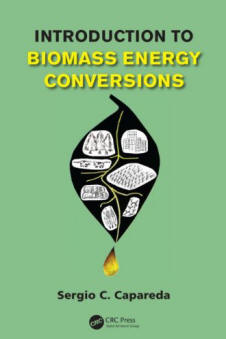Dr. Capareda’s Textbook on Renewable Energy (Posted October 15, 2019)
BOOK DESCRIPTION
Introduction to Renewable Energy Conversions examines all the major renewable energy conversion technologies, with the goal of enabling readers to formulate realistic resource assessments. The text provides step-by-step procedures for assessing renewable energy options, and then moves to the design of appropriate renewable energy strategies. The goal is for future engineers to learn the process of making resource estimates, through the introduction of more than 140 solved problems (and equal number of solved problems for teachers), over 165 engineering related equations, more than 120 figures and numerous tables to explain each renewable energy conversion type. A Solutions Manual, PowerPoint slides, and Lab Exercises will be available for instructors.
Key Features
- Covers all major types of renewable energy with comparisons for use in energy systems
- Discusses environmental, economic and social costs of renewables, sustainability, climate change, life cycle analysis (LCA), global warming, and greenhouse gases, CH4, NO2 and CO2
- Build skills for evaluating energy usage versus environmental hazards and climate change factors.
- Presents and explains the key engineering equations used to design renewable energy systems
- Uses practical approach to design and analyze renewable energy conversions
- Decision-making processes, environmental issues, profit and loss estimation , levelized cost of energy (LCOE), net energy balance (NEB), net energy ratios (NER), balance of systems (BOS)
- Offers a solutions manual, PowerPoint slides, and lab activity plans for instructors
Biofuels Textbook 2014 (Posted on 7/17/2013)
Introduction to Renewable Energy Conversions discusses major renewable energy conversion technologies with a global approach to energy resource assessment. Readers follow step-by-step procedures for selecting and integrating renewable energy options for a given location on a long-term basis, and selection of appropriate renewable energy strategies. Learn life cycle analysis (LCA) and levelized cost of energy (LCOE).
The potential that biomass energy has to supplement traditional fuels and reduce greenhouse gas emissions has put it front and center in the plan to replace fossil-based fuels with renewable fuels. While much has been written about biomass conversions, no single textbook contains all the information needed to teach a biomass conversion course—until now. Introduction to Biomass Energy Conversions presents a comprehensive review of biomass resources available for conversion into heat, power, and biofuels.
The textbook covers biomass characterization and discusses facilities, equipment, and standards (e.g. ASTM or NREL) used for analysis. It examines the range of biomass resources available for conversion and presents traditional biomass conversion processes along with extensive biomass characterization data tables, illustrations, and graphical presentations of the various biomass energy conversion processes. The author also describes how to set up a laboratory for biomass energy conversion, and presents economics and sustainability issues. Loaded with real-world examples, the text includes numerous worked examples and problems in each chapter.
No one knows what the price of oil will be next year or in future decades. It is governed by many factors other than supply and demand (politics, wars, etc.), however, whatever the future of energy is, bio-fuels will play an important role. This technical guide prepares students for managing bio-refineries, no matter what type of bio-fuel is produced. It also provides practicing engineers with a resource for starting a small bio-fuel business.
NEWEST EDITION! Introduction to Biomass Energy Conversions SECOND EDITION (Published Fall 2023)
Introduction to Biomass Energy Conversions explores biomass energy conversions and characterization using practical examples and real-world scenarios. It begins with biomass resource estimation and extends to commercialization pathways for economical biomass conversion into high-value materials, chemicals and fuels.
With extended discussions of new sustainability issues in biofuels production, such as carbon capture and sequestration (CCS), the 2nd Edition has been updated with carbon footprint (CF) work, life cycle analyses (LCA), the growing circular economy, and newer research directions of biomass resources, such as graphene production from biochar. This book covers thermo-chemical conversion processes, including torrefaction, pyrolysis, gasification and advanced gasification, biomass liquefaction, and combustion.
This book is intended for senior undergraduate students taking Renewable Energy Conversions, Bioenergy, Biofuels and Sustainable Engineering courses.
This book also features end of chapter problems, MCQs, laboratory exercises, and case studies with Solutions Manual for adopting instructors.
Fee Schedules for Beta Lab (Posted on 2/11/2013)



